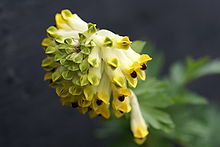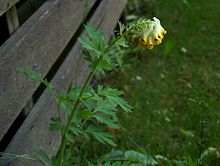- Corydalis nobilis
-
Corydalis nobilis Scientific classification Kingdom: Plantae Division: Magnoliophyta Class: Magnoliopsida Order: Ranunculales Family: Fumariaceae Genus: Corydalis Species: C. nobilis Binomial name Corydalis nobilis
(L.) Pers.[1]Synonyms Corydalis nobilis (Siberian corydalis) is a winter annual native to Siberia and Kazakhistan.[3] It was introduced to Europe by Linnaeus, who had asked his friend Erich Laxmann for seeds of Lamprocapnos spectabilis (old-fashioned bleeding heart), but was sent seeds of C. nobilis instead. Both Lamprocampnos and Corydalis are members of the Fumariaceae family, with seeds having an attached elaiosome that makes them attractive to ants, which disperse the seeds.
Contents
Description
C. nobilis bears its compact cymose inflorescence on a stem that can be as tall as 50 cm.[4] The stem may be upright, prostrate or climbing.[2] Leaves are most often compound and pinnate but sometimes simple.[2]
Its flowers are yellow or orange; inner petals have dark violet at the top.[4] The individual flowers resemble small snapdragons.[2]
The seeds of C. nobilis typically have elaiosomes[2] (a fatty body attached to the seed but not part of it, which can be eaten by ants without harming the seed within.) Seeds of C. nobilis are dispersed by ants,[5] who carry seeds away to feed on the elaiosomes. Myrmecochory (seed dispersal by ants) is also observed in other Fumariaceae[6] and has evolved independently in many other plant genera as well.[7]
Distribution
C. nobilis, first described based on seeds sent to Linnaeus from Siberia, is now widely dispersed throughout the world as an ornamental plant. It prefers moist soil to dry soil, and does well in full sun or partial shade. It is not winter-hardy below –5° F.[2]
Association with Linnaeus
Linnaeus had seen a drawing of Lamprocapnos spectabilis (old-fashioned bleeding heart) in the thesis of a Russian student who was describing many Siberian plants. He longed to see a living specimen of this flower for himself. In 1765, he was delighted to receive seeds from Siberia that he thought would grow into bleeding heart plants, but the seeds were instead for a different member of the Fumariaceae family, C. nobilis. The seeds were sent to Linnaeus by his friend Erich Laxmann; they originated from a Siberian mountaintop in the northwestern Altai Range.[8] They had not previously been known in Europe.[9][10]
Seeds of C. nobilis spread throughout Europe from Linnaeus's garden in Hammarby, reaching England's Kew Gardens in 1783.[11] After the death of Linnaeus, C. nobilis self-seeded throughout his garden, becoming a weed.[12]
References
- ^ a b c "Fumaria nobilis L.". Missouri Botanical Garden. http://www.tropicos.org/Name/50152000. Retrieved 18 July 2011.
- ^ a b c d e f "Corydalis nobilis (Corydalis)". Zipcode Zoo. http://zipcodezoo.com/Plants/C/Corydalis_nobilis/. Retrieved 11 July 2011.
- ^ "Taxon: Corydalis nobilis (L.) Pers.". GRIN. http://www.ars-grin.gov/cgi-bin/npgs/html/taxon.pl?408086. Retrieved 7 July 2011.
- ^ a b "Corydalis nobilis (L.) Pers.". Encyclopedia of Life. http://www.eol.org/pages/2906177. Retrieved 11 July 2011.
- ^ Linnaeus Hammarby (pamphlet). University of Uppsala. 2011.
- ^ Nakanishi, H. (1994). "Myrmecochorous adaptations of corydalis species (Papaveraceae) in southern Japan". Ecological Research. doi:10.1007/BF02347236. http://www.mendeley.com/research/myrmecochorous-adaptations-of-corydalis-species-papaveraceae-in-southern-japan/.
- ^ Lengyel S, Aaron D. Gove, Andrew M. Latimer, Jonathan D. Majer, Robert R. Dunn (2009). "Ants sow the seeds of global diversification in flowering plants". PLoS ONE 4 (5): e5480. doi:10.1371/journal.pone.0005480. PMC 2674952. PMID 19436714. http://www.pubmedcentral.nih.gov/articlerender.fcgi?tool=pmcentrez&artid=2674952. "Myrmecochory, which has evolved independently at least 100 times in angiosperms and is estimated to be present in at least 77 families and 11,000 species, is a key evolutionary innovation and a globally important driver of plant diversity."
- ^ Tebbit, Mark C.; Magnus Lidén, Henrik Zetterlund (2008). Bleeding hearts, Corydalis, and their relatives. Timber Press. pp. 126. ISBN 0881928828. http://books.google.com/books?id=_OLFpOtEAE0C.
- ^ "Online Linné: Fråga" (in Swedish). University of Uppsala. http://www.linnaeus.uu.se/online/fraga/djur_64.html. Retrieved 12 July 2011. "Seeds of Siberian corydalis which he received from Erik Laxman (sown in 1765 in Uppsala, Sweden) were believed to be the much sought after Fumaria spectabilis, but turned out instead to be a new species, a species that today are common wild from Linnaeus' garden in the parks around Uppsala."
- ^ (In Swedish: Frön av sibirisk nunneört som han fått från Erik Laxmann (såddes 1765 i Uppsala) troddes vara den mycket eftersökta Fumaria spectabilis, men visade sig i stället vara en ny art, en art som idag är vanlig förvildad från Linnés trädgård i parker runt om i Uppsala.)
- ^ Tebbit, Mark C.; Magnus Lidén, Henrik Zetterlund (2008). Bleeding hearts, Corydalis, and their relatives. Timber Press. pp. 13. ISBN 0881928828. http://books.google.com/books?id=_OLFpOtEAE0C.
- ^ "Linnaeus' garden". University of Uppsala. http://www.linnaeus.uu.se/online/life/7_2.html. Retrieved 7 July 2011.
External links
Categories:- Fumariaceae
- Flora of Siberia
Wikimedia Foundation. 2010.


